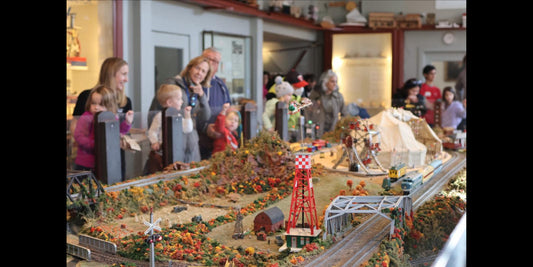The cover of Connecticut Architecture: Stories of 100 Places makes an argument right up front: that Connecticut’s architecture is more than just Colonial homesteads and picturesque lighthouses. Residents already know this, of course, but even lifelong residents will likely find something new in this handsome, oversized book, illustrated with 173 color photographs, that presents a comprehensive and intriguing history of the state’s structural bounty. The survey begins with a bold, angled view of the state capitol’s granite and gold exterior on the cover, inset with photographs of a stained glass-filled church, a soaring railroad bridge, an iron-making furnace and, yes, a homestead and a lighthouse.
Author Christopher Wigren, writing for the Connecticut Trust for Historic Preservation (headquartered in Hamden), begins with a broad definition of “architecture” that sets the scene for his 100 locations. Architecture, he says, is “the art and science of making places,” in which “art” refers to “people’s efforts to make what they build beautiful” and “science” refers to architecture’s “practical or technical aspects.” Wigren casts a wide net, including not only structures themselves but also their interiors, their surrounding landscapes and even larger cohesive constructions like planned streets, neighborhoods and towns. As a result, we can see our state in new ways.
sponsored by
The book begins with a history of Connecticut and its places that runs comprehensively from the topography of the land as shaped by its first native peoples to the postwar Modernism that claims New Haven, “uniquely located at the intersection of academia and aggressive urban renewal,” as one of its centers. This history is liberally accompanied by photographs and well worth a read on its own, but the book’s greatest appeal is the 12 sections that follow, highlighting different facets of Connecticut architecture: landscapes, “materials and technologies,” homes, farms, factories, towns and cities, transportation, public buildings and so on. As Wigren emphasizes in his preface, Connecticut Architecture doesn’t offer a list of greatest hits. Rather, it uses some of our most interesting, iconic or illustrative places to tell the tale of a state rich in architectural variety and stories.
New Haven is the site of seven of the book’s 100 entries. Beaver Hills is presented as an example of a planned neighborhood where architects were, nevertheless, encouraged to build in whatever style they pleased. The “eclectic” result is neighboring homes ranging from Arts and Crafts bungalows to Georgian mansions to Italian villas to Cotswold cottages. But Wigren argues there’s more to Beaver Hills than meets the eye: “Behind their porticoes or loggias or half-timbering, the houses are remarkably similar. They are built to the same scale, and with a rather narrow range of materials… Inside, the houses have many of the same plans, and certainly the same selection of rooms, to accommodate a middle-class lifestyle.” In the end, he argues, their interior similarities far outweigh their exterior differences.
New Haven’s Dixwell neighborhood is included in the book for a different reason, as an example of the aggressive urban renewal of the 1960s, which has left what Wigren calls a “difficult legacy” in many cities. The strategies of that movement, he writes, placed “too much responsibility for social ills, and too many hopes for curing them, on architecture.” What remains intact of the renewal plan for Dixwell is the Dixwell Avenue Congregational United Church of Christ, designed in 1968 by New Canaan architect John M. Johansen, “who at the time was experimenting with dramatic, irregular forms in place of the simplicity of earlier Modernist designs.” The congregation itself, we’re told in the book’s introduction, had “been considering a Colonial Revival edifice before the Redevelopment Agency assigned the Modernist architect” to it.
Also among the book’s 100 architectural touchstones are Wooster Square’s Willis Bristol House, the New Haven Green, Yale Divinity School, Yale’s Kroon Hall and local homes built by the popular 1920s architect Alice Washburn. But perhaps the greater recommendation for New Haven readers is all the book can teach us about the rest of the state. Many other places of interest emerge as a portal into understanding aspects of Connecticut with which we may be less familiar, at least in our daily lives.
The Arcade in Bridgeport, a “sunlight-flooded iron-and-glass atrium ringed with shop fronts on two levels” built in 1889, is identified as “Connecticut’s first shopping mall.” Torrington’s Warner Theatre is “Connecticut’s best-preserved movie palace.” Two New London lighthouses illustrate the differences in preferred construction methods at the times they were built. Connecticut’s first state house, commissioned in 1792 in Hartford, “demonstrate
A journey through Connecticut Architecture is much more than your average survey of historic buildings, styles, periods and characteristics. Rather, it inspires another journey—one you might want to undertake on your own, beginning with a drive through the city and beyond.
Photo Key:
1. Detail of Kroon Hall.
2. An Alice Washburn-designed house in Spring Glen, Hamden.
3. Dixwell Avenue Congregational United Church of Christ.
4. Christopher Wigren with Jane Montanaro outside the CT Trust for Historic Preservation.
Connecticut Architecture: Stories of 100 Places
by Christopher Wigren (Wesleyan University Press, 2019)
RJ Julia | HFS Books | Barnes & Noble | Amazon
Book Talk and Signing on 1/17
Written by Kathy Leonard Czepiel. Images 1 and 3 photographed by Dan Mims. Images 2 and 4 photographed by Kathy Leonard Czepiel.








